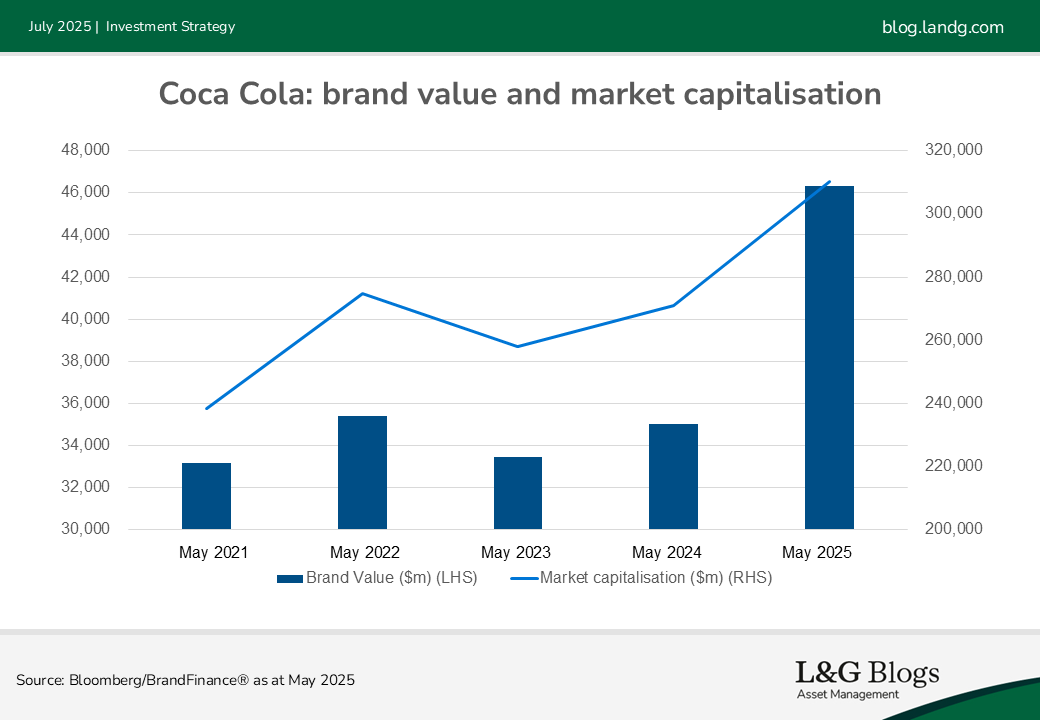Disclaimer: Views in this blog do not promote, and are not directly connected to any L&G product or service. Views are from a range of L&G investment professionals, may be specific to an author’s particular investment region or desk, and do not necessarily reflect the views of L&G. For investment professionals only.
Spotlight on the world’s strongest brands: Coca-Cola
In this blog series, we focus on three leading global companies, showing how a strong brand can contribute to financial performance across a range of sectors. This time, we look at Coca-Cola*.

Founded in 1886, Atlanta-headquartered Coca-Cola is the world’s largest non-alcoholic beverage company, with a portfolio of 200 brands covering carbonated soft drinks, water, sports drinks, energy drinks, juice and coffee.
Together with bottlers and distribution partners, the company sells finished beverage products bearing Coca-Cola and licensed brands through retailers and food-service locations in more than 200 countries and regions globally.
A truly international, scalable business model
Two-thirds of Coca-Cola’s total revenue is from overseas[1], and the majority is from emerging economies such as Latin America and Asia Pacific.
Coca Cola’s business model is capital-light and primarily focused on owning brands and formulas. It operates a concentrate model and has a strong distribution platform via its franchised bottlers. The Coca-Cola Company charges bottlers a fixed price per unit of concentrate, before they sell products to customers. This model results in a scalable, higher margin business that allows Coca-Cola to focus on marketing and aligning innovation with consumer demand.
Coca-Cola has grown its share in the non-alcoholic ready to drink market to 28%, with 41% occupied by 80 large players and the rest by shifting players. It has positioned itself as an explorer (operating in augmented reality/virtual reality), a challenger (innovation with social media presence), and a leader (investment in the value of the Coca-Cola brand).[2]
Steady organic growth and strong shareholder returns
Coca-Cola’s latest results exceeded analyst expectations, and the company said it expects to meet bottom line and organic growth expectations for 2025, helped by favourable currency moves. Earnings per share were maintained over 2025, providing good visibility, while organic revenue rose 5.9%.
Coca-Cola’s business strategy that favours growth and efficiency has resulted in positive long-term growth guidance, with 4-6% organic revenues (well above its peer group), 7-9% comparable currency-neutral earnings per share, and most importantly shareholder returns, primarily in the form of dividends. More than $8bn were paid in dividends in 2024, out of $12bn earnings before interest, taxes, depreciation and amortisation.
What is the Coca-Cola brand worth?
BrandFinance® is the leading name in independent brand valuation. According to its analysis, Coca-Cola is consistently the most valuable non-alcoholic drinks brand in the world. The agency also highlights Coca-Cola’s progress in becoming a consumer-centric, data-rich brand with truly global reach.
A recent collaboration with Universal Music Group* saw Coca-Cola build on its longstanding sponsorship of live music events by launching Real Thing Records.[3] The label aims to provide a platform for emerging artists from around the world, focusing on finding talent rather than specific genres.
As shown below, BrandFinance®’s assessment suggests these initiatives are succeeding, with the value of the Coca Cola name rising significantly in its latest report.
Brand value has increased by 15% from 2025 to 2025, and it represents almost 20% of the firm’s enterprise value, demonstrating how the brand contributes strongly to the business performance. Key to this growth has been the diversification of product offering into energy, coffee and sparkling drinks, as well as the broad consumer appeal of the zero-sugar brand.

Sustainability in focus
Coca Cola has not been immune from controversies around the impact of the food sector on water use and pollution.
However, it has made positive commitments to improve the sustainability of its operations. In an effort to simplify the recycling process, in a 2024 pilot Coca-Cola sold label-free Sprite bottles. By 2030, the company aims to reduce its total water use ratio by 10% compared with 2019, and to replenish 100% of water uses for beverages.[4]
The company has also made a commitment to regenerative water use in locations where production facilities rely on vulnerable water sources or have high water dependencies.
Risks to consider
Coca-Cola has already guided to some currency headwinds in 2025. While the softening of the US dollar may in theory benefit Coca-Cola’s bottom line (Coca-Cola charges bottlers a percentage of local currency revenue, so US dollar depreciation would lead to higher revenues), their hedging for currency movements may have the opposite effect.
The Make America Healthy Again (MAHA) Commission established in February could bring some headline risks should it add restrictions on sugary drinks or snacks, but Coca-Cola is well insulated given its international revenues. Coca-Cola is also interested in positioning itself as a truly international company reenforcing the ‘localness’ of the brands in each geography and customised offerings, to protect itself from potential boycotting of US products by consumers.
*For illustrative purposes only. Reference to a particular security is on a historic basis and does not mean that the security is currently held or will be held within an L&G portfolio. The above information does not constitute a recommendation to buy or sell any security.
[1] Source: Bloomberg as at June 2025.
[2] Source: Consumer Analyst Group of New York (CAGNY) 2025 conference.
[3] Source: Coca-Cola launches label ‘real thing records’ in partnership with Universal Music Group - Music Business Worldwide
[4] Source: https://www.cocacolaep.com/sustainability/this-is-forward/water/
Recommended content for you
Learn more about our business
We are one of the world's largest asset managers, with capabilities across asset classes to meet our clients' objectives and a longstanding commitment to responsible investing.

